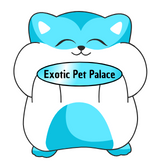Why Does My Sugar Glider Nibble On Me?
Sugar gliders are appealing little animals noted for their friendly and affectionate interactions with their owners. If you’ve spotted your sugar glider nibbling on you, you might wonder why.
In this article, we are going to share a detailed discussion on the nibbling behavior of sugar gliders.
We will try our best to cover the following topics:
➡Reasons behind Why Does My Sugar Glider Nibble On Me?
➡How to Discourage Undesirable Nibbling?
➡What are some desirable nibbling behaviors of sugar gliders?
➡How can I bond better with my sugar glider?
Let’s start:
Also Read:
Why Do Sugar Gliders Bark At Night?
Sugar Glider Nibble Types: Quick Reference
Sugar glider nibbling can be a source of confusion for new owners. Here’s a table to help you differentiate between desired and undesired nibbling behaviors:
| Nibble Type | Description | Meaning | Action |
|---|---|---|---|
| Gentle & Licking | Soft nibbles with tongue movements | Grooming behavior | Enjoy the interaction |
| Playful | Light nibbles on fingers/clothing during playtime | Exploration & Interaction | Continue playtime |
| Hard Bites | Strong, persistent nibbling | Fear, Stress, or Threat | Provide comfort, remove stressor |
| Jewelry | Nibbling on shiny objects | Attraction to shine | Distract with a toy |
| Boredom Nibble | Persistent nibbling due to lack of stimulation | Seeking attention or entertainment | Increase playtime, add toys |
All in all, gentle nibbles are usually positive, while harder bites or persistent nibbling indicate a problem.
Consider the situation – is your glider new to the environment? Do they have enough toys and climbing structures?
Focus on rewarding desired behaviors with praise or treats.
Note: Punishing your glider for nibbling can damage trust and lead to more behavioral problems. So, never punish your sugar glider for nibbling.
5 Reasons Behind Why Does My Sugar Glider Nibble On Me?
Sugar gliders are intelligent and social creatures. When your sugar glider nibbles on you, it can be a sign of various behaviors and emotions.
Here’s a breakdown of what your sugar glider’s nibbling might mean:
👉Territorial Nibbling
Sugar gliders nibble to show the right over their territory or resources. This occurs more frequently when there is competition for food or space.
If you’re new to your sugar glider or have introduced new items to their surroundings, they may nibble you for claiming their territory.
👉Taste Nibbles
Sugar gliders are naturally curious and use their mouths to explore their surroundings.
They might nibble on your fingers, clothing, or hair simply to investigate the texture and taste.
This is particularly common with young joeys (baby sugar gliders) who are still learning about the world.
👉Boredom Nibbling
Sugar gliders, like any other pet, can become bored if their surroundings are not stimulating enough.
If they don’t have enough climbing toys, pouches to investigate, or opportunities to engage with you, they may turn to nibbling you to keep themselves entertained.
👉Communicative Nibbling
Nibbling can also be used to communicate during grooming or social interactions.
It is a means for sugar gliders to communicate their needs and emotions.
If your sugar glider nibbles you while playing or cuddling, they may be attempting to engage with you or seek your attention.
👉Stress or Fear Nibbling:
While less common, nibbling can also be a sign of stress or fear in sugar gliders.
If your glider feels threatened or overwhelmed in a new situation, they might resort to gentle nibbling as a way to test the situation.
How to Discourage Undesirable Nibbling?
The good news is that with patience and understanding, you can discourage undesirable nibbling behaviors and build a trusting relationship with your sugar glider.
Here are some helpful tips:
Positive Reinforcement:
When your sugar glider interacts with you in a positive way (playing, cuddling, etc.), reward them with a healthy treat or praise. This reinforces desired behaviors and strengthens the bond between you.
Provide Enrichment:
Make sure your glider’s habitat is exciting, with plenty of climbing toys, pouches, and textures to investigate. Allow them to play outside the cage on a regular basis under supervision, and switch toys periodically to keep them engaged.
Scent Consistency:
Wash your hands after handling food or applying lotions with strong fragrances. Sugar gliders are sensitive to smells, and unexpected scents may prompt inquisitive nibbling.
Respect Your Glider’s Boundaries:
If your glider appears stressed or terrified, give them space. Attempting to compel engagement can exacerbate the issue and lead to increased nibbling.
Gentle Discouragement:
If your glider begins to nibble too hard, gently but firmly withdraw your hand and provide a chew toy as a substitute. Avoid making loud noises or rapid movements, which can frighten your glider.
Remember, it is critical to understand the context of the nibbling. If it is soft and occurs at times of relaxation or play, it is most often a beneficial interaction.
However, if the nibbling is followed by hissing or other symptoms of distress, it could suggest anxiety or pain, and you should try to console your sugar glider or address any underlying problems.
In conclusion, nibbling is a natural behavior for sugar gliders that can indicate a variety of things, including exploration, taste testing, communication, and attachment.
Observing the situation and responding accordingly can help ensure that your encounters with your sugar glider are pleasant and joyful.
What Are Some Desirable Nibbling Behaviors Of Sugar Gliders?
Not all nibbling by sugar gliders is undesirable. In fact, some gentle nibbling behaviors can be a sign of affection and bonding between you and your glider.
Here are some examples:
👉Grooming Nibbles:
As previously stated, sugar gliders groom one another and occasionally extend this behavior to their trusted humans.
Gentle nibbles and licks can indicate that your glider recognizes you as a member of their colony and wishes to keep you clean (in their own way!).
👉Playful Nibbles:
During playtime, your glider may bite on your fingers or clothing. This is often a delicate investigation that should cause no pain. It’s a good sign that your glider is content and enjoying your company.
Key Point: The key to identifying desirable nibbling is the intensity and context. Gentle nibbles with licking are positive signs, while harder bites or persistent nibbling might indicate something else is going on.
How to Encourage Desirable Nibbling?
There are a few ways to encourage these positive interactions:
- Bonding Time: Spend quality time with your glider each day, allowing them to climb on you and explore your clothing. This strengthens your bond and makes them feel more comfortable with gentle nibbling.
- Positive Reinforcement: When your glider exhibits gentle nibbling during playtime, reward them with praise or a small, healthy treat. This reinforces the desired behavior and encourages them to repeat it.
Remember: Even desirable nibbling can become excessive if your glider is bored or lacks stimulation.
Ensure their environment is enriched with climbing toys and pouches, and offer regular playtime to keep them engaged.
What Are Some Other Common Behaviors of Sugar Gliders?
Here is list of common sugar glider behaviors.
Social and communicative behaviors:
- Barking: Sugar gliders, like miniature puppies, bark to communicate with others, which might occur at night due to their nocturnal habits.
- Crabbing: A distinct sound resembling a swarm of locusts, suggesting that the sugar glider is scared or uncomfortable with the surroundings.
- Hissing can vary in volume and duration and communicate a variety of meanings, ranging from a simple hello to a gesture of dissatisfaction.
- Purring: A happy, comfortable sugar glider may purr, but it is not as loud as a cat’s purr.
Instinctive behaviors:
- Scent Marking: Sugar gliders mark their territory and identify themselves with saliva, urine, and gland secretions.
- Climbing and jumping are natural behaviors for sugar gliders, who feel safest higher up and avoid the ground if feasible.
- Gliding: They are great gliders and can spring across a room, as is their natural behavior in the wild.
Daily routines:
- Sleeping during the day: Sugar gliders are nocturnal, meaning they sleep deeply during the day and become active at night.
- Eating in the Evening: They are more active and hungry in the evening, so make sure fresh food is available if they wake up after you go to bed.
Unhappy behaviors:
- Shaking: Some sugar gliders shake or shiver when they first wake up, but excessive shaking can signal a health problem.
- Scratching: In the wild, they scrape trees to extract sap, thus they may scratch or scrape their teeth against your limbs.
Understanding these behaviors will allow you to provide a better environment for your sugar gliders and more effectively respond to their needs.
If you see any strange behavior or symptoms of distress, consult a veterinarian or a sugar glider specialist for assistance.
Remember, each sugar glider is unique, and learning about their particular personalities and behaviors is part of the fun of owning them as pets.😊
9 Tip on How Can I Bond Better With My Glider?
Bonding with your sugar glider is a pleasurable process that can help you strengthen your relationship with your pet.
Here are 9 techniques and suggestions to help you better bond with your sugar glider:
1- Let Your Sugar Glider Adjust: Before you try to interact with them too much, give them time to adjust to their new surroundings. They need time to feel protected and secure.
2- Familiarize your scent: Put a piece of your used clothing in their cage so they can become accustomed to your fragrance. This allows them to recognize and become acquainted with you.
3- Offering treats: Treats can be an effective approach to create trust. Determine what foods your sugar glider like and use them to reward interactions with you.
4- Spend Quiet Time Together: Sit near their cage and talk quietly, or simply be present. This helps them become accustomed to your presence without feeling intimidated.
5- Bonding Pouch: Transport them in a bonding pouch. This keeps them close to you, allowing them to feel your warmth and hear your heartbeat, which can be extremely calming.
6- Gentle Handling: When your sugar glider is ready, handle it gently. Avoid grasping them and instead allow them to approach you on their own terms.
7- Play and Interaction: Spend time with toys and activities that they enjoy. This not only entertains them but it also strengthens your relationship.
8- Be constant in your interactions. Regular, good experiences can help to strengthen the link between you and your sugar glider.
9- Patience: Remember that connecting takes time. Be patient and do not rush the process. Each sugar glider is unique, thus some may take longer to bond than others.
For more details read our article: 👉How to bond with a sugar glider?
Conclusion:
At the end, I hope you have got the answer of your question that Why does my sugar glider nibble on me?.
For more updates, Follow us on👇
Remember, with a little patience and understanding, those gentle explorations can transform into a language of affection and playful interaction.
So, embrace the nibble✨, address the bite✨, and embark on a joyful journey of bonding with your own pocket-sized wonder.💖
Happy Gliding!😊

